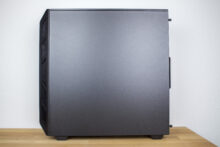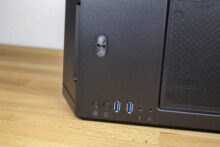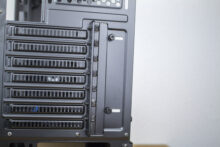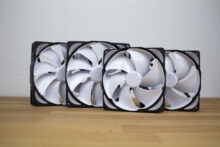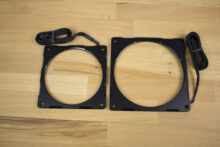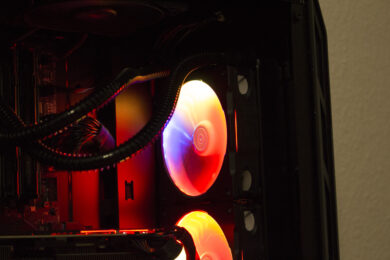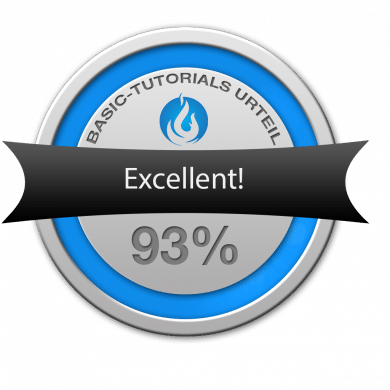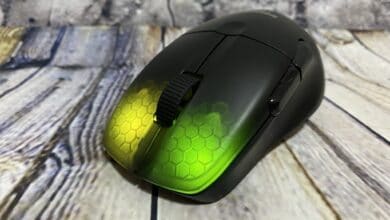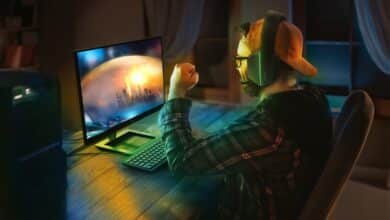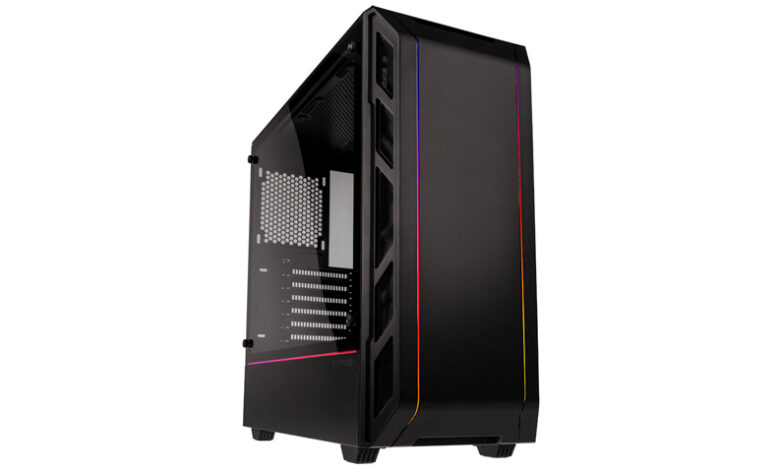
With the Eclipse P350X, Phanteks has released a new entry-level case for motherboards up to E-ATX format, which despite its low price will impress with numerous features. The compact Midi Tower is equipped with RGB lighting in front and side. There is also a large tempered glass window on the left side. As it is now standard with the better cases, a power supply cover is not dispensed with either.
All in all the specifications of the Phantek Eclipse P350X read very well and sound like more than a price of only Product. If and where Phanteks makes cuts to reach this price, we clarify in the following test report for you.
Scope of Delivery
The Phanteks Eclipse P350X Midi-Tower is well and safely packed. Due to the Tempered Glass side, this must also be the case. We find the accessories in a cardboard box in the front, where the hard disk cages are hidden. Beside some cable ties all necessary screws are present here. We also find a small manual that explains the most important features. This is particularly useful for RGB lighting.
Two SSD mounts are already mounted, as are the fan and two HDD mounts. Also the spacers for the mainboard are pre-installed. So you can start directly with the system construction.
Design
With its design, the Phanteks Eclipse series is aimed at gamers. This is also the case with the Phanteks Eclipse P350X. Optically, it stands out from the crowd without exaggerating. The case is relatively plain black, just like the Eclipse P300. The large tempered glass pane on the left side is conspicuous at first glance. It does not extend over the entire side, but starts above the power supply cover. The hardware can then be inspected here. But at second glance we find even more striking differences.
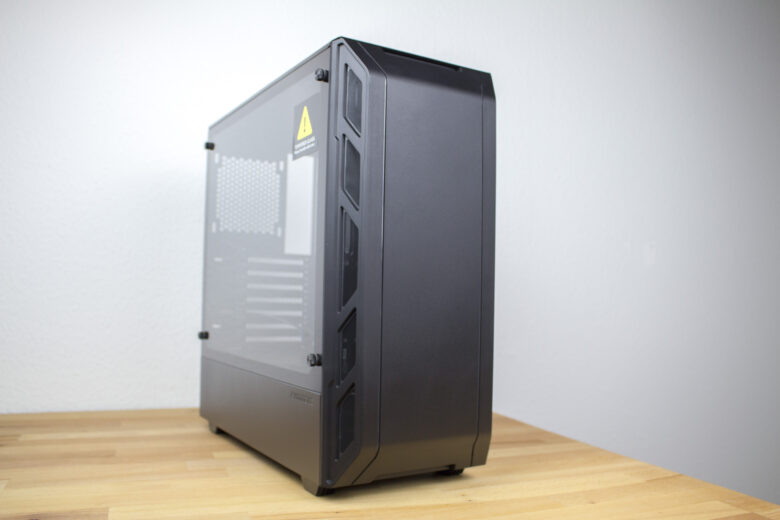
Especially with RGB lighting you can upgrade your gaming system significantly. Since Phanteks only have an indirect influence on the interior, the manufacturer starts with the RGB lighting outside the housing. There are two LED strips on the front. Also between the power supply cover and the glass pane. The lighting can be controlled either via two switches on the I/O panel, or via a 3-pin RGB header from a compatible motherboard. Yeah, you read right – 3-pin. What’s the meaning of this?
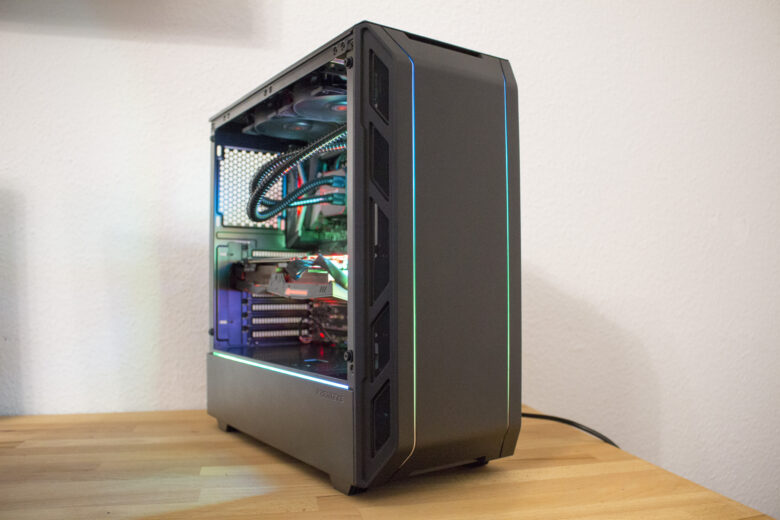
The RGB lighting is digital and therefore addressable. The LED strips can therefore not only light up in one colour, but in several at the same time. It’s especially cool when the fan, mainboard and graphics card are also equipped with digital RGB lighting and you can chase a light wave or similar through the hardware. Synchronization with other peripheral devices is also conceivable. Asus supports this with its Aura software, for example. But the other manufacturers with digital 3-pin RGB headers are of course also compatible. Other RGB products from Phanteks can easily be connected in series to connect additional LED strips or fans, for example.
Inside, Phanteks gives its customers the choice – either white or black. From the outside, the case is only available in black, at least until now. We decided to test the completely black version.
As mentioned above, the I/O panel of the Phanteks Eclipse P350X has two switches to control the RGB lighting. There is also a microphone input and an audio output. Two USB 3.0 ports are also still available. The I/O panel is located in the front area of the upper side of the housing.
On the positive side, Phanteks was concerned about the proper routing of the cables. Through various openings in the mainboard tray the cables can be laid cleanly and hidden for the most part. Especially the power supply cover contributes to this.
Workmanship
With a price of Product the Phanteks Eclipse P350X is clearly in the entry-level class – especially with the rich feature set! Nevertheless Phanteks knows how to convince as always with quality. The case is made of plastic and glass, steel and not aluminium, but the workmanship is neat and the case is surprisingly light.
Of course, you have to make slight compromises. In my opinion, the power button doesn’t have an ideal pressure point, but can still be operated without restrictions. The buttons to control the lighting have a better pressure point.
Inside, while building the system, there will also be some further points of criticism to be found, which we will discuss later. These concern less the workmanship, but rather the conception of the housing.
Equipment
The Phanteks Eclipse P350X Midi-Tower offers like most Midi-Towers a very good hardware support. Up to 40 cm long graphics cards and 160 mm high CPU coolers can be used. A 120 mm fan is already pre-installed, but it is not yet sufficient for a good airflow. But it’s also a cheap case.
| Model: | Eclipse P350X |
| Housing Type: | Midi Tower |
| Dimensions: | 200 mm (W) x 450 mm (H) x 455 mm (D) |
| Material: | Steel, Plastic, Tempered Glass |
| Color: | Black, Black & White |
| Drive bays: |
|
| Extension slots: | 7 |
| Form factors: | E-ATX (up to 280 mm), ATX, mATX, mini-ITX |
| Aeration: |
|
| Radiators: |
|
| Max. CPU cooler height | 160 mm |
| Max. Graphics card length | 400 mm |
| Place for cable management | 36 mm |
| Max. Power supply length (incl. cables) | 250 mm |
| Price | Product |
The housing is only partially suitable for water cooling. A large radiator can only be installed in the front. Although there is (theoretically) enough space on the top for two 140 mm fans, the distance to the mainboard is too small for a radiator to fit there. Even for fans it’s getting tight.
Removable holders or similar, as you know it from the top models of Phanteks, are of course not found in this case. This is only possible with the hard disk holders. These are also decoupled, by the way.
But you don’t have to do without dust filters. These can be found both under the power supply unit and in the front. A magnetic grid is placed on the top, which can be easily removed. But also the other filters are easily and quickly dismantled for cleaning.
System Construction in Phanteks Eclipse P350X
The Phanteks Eclipse P350X supports motherboards up to the E-ATX form factor – but with a restriction to 280 mm width. We installed a normal ATX mainboard, the MSI Z370 Gaming Pro Carbon*. The processor is a of the8auer Core i7-8700K Advanced Edition* with 5.2 GHz overclocking. As RAM the system currently uses 32 GB Crucial Ballistix Sport LT RAM with 2.400 MHz – this will soon be replaced by Crucial Ballistix Tactical Tracer RGB RAM* with 3.000 MHz. The graphics card used is an ASUS GeForce GTX 1080 Ti STRIX*. A modular Seasonic Focus+ 80 Plus Platinum power supply with 750 Watt provides the necessary power.
Naturally, the system must also be cooled accordingly. A be quiet! silent loop complete water cooling with 240-mm radiator knows how to tame the processor. In addition, we wanted to give the case better ventilation and the hardware a better look. Therefore two Noiseblocker NB-eLoop fans with 120* or 140 mm* should provide cooling. The fans are known for their silent properties and were developed in Germany. Optically, additional matching Phanteks Halos Lux Digital fan frames should be mounted in 120* or 140 mm* on the fans. Unfortunately, the plan didn’t work out – why?
The Phanteks Eclipse P350X is really quite tight. While the installation of the water cooling in the front including Noiseblocker eLoop fans and Phantek’s Halos Lux Digital fan frame was no problem, the installation on the top side turned out to be difficult. Both the heat sink and a fan header were in the way. It was not possible to mount the large 140 mm fans – even without the fan frames. That’s why you can see the 120 mm fans of the be quiet! water cooling system on our photos of the system. We would have liked to have had other fans at this point, but the lack of space did not allow this. With other mainboards and fans it can look quite different, of course, but in our constellation the installation of the 140 mm fans was not possible.
Apart from that, it’s fun to screw in the Phanteks Eclipse P350X. The top can be removed for easy access to everything. The mainboard tray has a cut-out to change the fan afterwards, without having to remove everything again.
To the right of the mainboard tray there is a small highlight, which also serves as a lead-through for the cables (without rubber edges). It expands the space on the back of the mainboard tray to allow easier cable routing. Two hook-and-loop fasteners are already available for fixing the cables for optimum cable management. Additionally Phanteks has included some cable ties. However, many holders are not found on the back. Especially the 4+4-pin CPU connector was not very clean to install. The rest, however, went without a hitch.

The power supply unit is located in a separate room, where many cables can be hidden. The position of the hard disk cage is also unusual here. The two SSDs can be mounted behind the mainboard – as you know it. The hard disk cage is located below the power supply cover – unless unusual. But the hard disks are inserted from the front. To do this, first remove the front, which is held in place by a few plastic clips.
Of course, we also had to try out the RGB lighting of the housing. We have connected them to the MSI Z370 Gaming Pro Carbon motherboard for this purpose. And that’s where the problems started. The MSI Mystic Light software is unfortunately still very immature, which is why a meaningful control via this is hardly possible. That’s not Phanteks, it’s MSI. Also the control of the lighting of the mainboard already causes problems. If you really want to synchronize with other products, you should use an Asus mainboard. Also the Aura Sync software is not yet perfect, but already more advanced than that of MSI. Also Gigabyte RGB Fusion is of course compatible with the lighting. Alternatively, the Phanteks controller, which is already integrated in the housing, can be used to control the system. The lighting control of Phanteks is really great and can be easily extended, but does not include motherboard and graphics card. By the way: The Phanteks Digital RGB Controller Hub is also available separately, making it possible to retrofit any housing.
Conclusion on the Phanteks Eclipse P350X
With the Eclipse P350X, Phanteks has presented a successful successor to the Eclipse P300 that jumps on the trend of RGB lighting. The case is located in the manufacturer’s low price segment and accordingly dispenses with some features that can be found in the upper price regions. Also the clearance is unfortunately not ideal at least at the upper side. Overall, however, the case leaves a very good impression. As always, the workmanship quality of Phanteks is convincing.
With a price of Product, the Phanteks Eclipse P350X is an excellent choice if you want to save a little money on your gaming PC without sacrificing current trends and good workmanship.
Phanteks Eclipse P350X
Workmanship
Design
Features
Cooling
Value for Money
Great!
The Phanteks Eclipse P350X is an outstanding case in the low price segment that inspires with many features.

